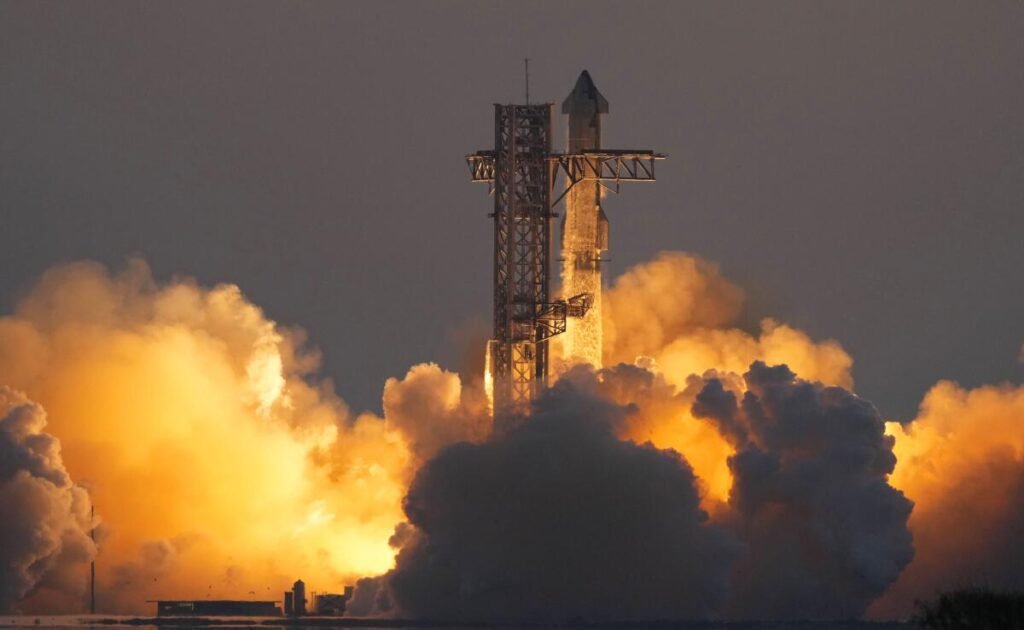
“SpaceX Celebrates Milestone: Super Heavy Booster Caught Mid-Flight for the First Time”

SpaceX has achieved a groundbreaking milestone in space technology by successfully catching its Super Heavy rocket booster mid-air during a test flight on October 13, 2024. This historic event marks the first time such a maneuver has been executed, showcasing SpaceX’s commitment to developing a fully reusable rocket system.
The Historic Flight
On the morning of October 13, SpaceX launched the Super Heavy booster from its Boca Chica facility in Texas at 7:25 a.m. CT (12:25 GMT). The booster, towering at 233 feet (71 meters), propelled the Starship rocket into space before detaching at an altitude of approximately 70 kilometers (40 miles) to begin its descent back to Earth.
Innovative Recovery System
The recovery of the Super Heavy booster was facilitated by a unique system known as “Mechazilla,” which features large mechanical arms designed to catch the booster as it returns. During its descent, the booster reignited three of its 33 Raptor engines to slow down, successfully maneuvering into position for capture by the launch tower’s arms.SpaceX engineers described the event as “a day for the history books,” celebrating the flawless landing that exceeded expectations. Initial concerns that the booster might land in the Gulf of Mexico were alleviated when it successfully returned to the launch pad.
Significance for Future Missions
This achievement is pivotal for SpaceX’s broader goals, particularly in relation to NASA’s Artemis program, which aims to return astronauts to the Moon. A fully reusable rocket system is essential for reducing costs and increasing the frequency of space missions.The successful catch not only demonstrates SpaceX’s engineering prowess but also sets a precedent for future missions, including potential crewed flights to Mars. The ability to rapidly reuse rocket components could significantly enhance mission planning and execution timelines.
Engineering Highlights
- Launch Time: October 13, 2024, at 7:25 a.m. CT.
- Booster Height: 233 feet (71 meters).
- Engine Count: 33 Raptor engines.
- Recovery Method: Catching with mechanical arms (Mechazilla).
Conclusion
The successful mid-air catch of the Super Heavy booster represents a significant leap forward in reusable rocket technology. As SpaceX continues to refine its systems and prepare for future missions, this achievement lays a solid foundation for ambitious plans in human space exploration. With each successful test flight, SpaceX is not only pushing boundaries but also redefining what is possible in aerospace engineering.

What are the implications of this achievement for future space missions
Enhanced Reusability and Cost Reduction
Cost Efficiency: The ability to catch and reuse rocket boosters dramatically lowers the costs associated with space launches. Traditional expendable rockets require a new vehicle for each mission, often costing millions of dollars. SpaceX’s reusable system could reduce launch costs by a factor of 100, making space more accessible to both governmental and commercial entities. Rapid Turnaround: The design of the Mechazilla system allows for quick refurbishment and relaunch of the Super Heavy booster, potentially enabling launches within minutes of recovery. This rapid reusability could lead to increased launch frequency, facilitating more missions in shorter time frames.
Broader Mission Capabilities
Lunar and Mars Exploration: SpaceX’s advancements are crucial for NASA’s Artemis program, which aims to return humans to the Moon by 2026. The successful catch validates the Starship’s design for lunar missions and supports long-term goals for Mars colonization. The technology developed could also be applied to future interplanetary missions, enhancing humanity’s ability to explore beyond Earth.Commercial Opportunities: The implications extend beyond government missions; commercial ventures could flourish as lower launch costs make space more viable for satellite deployment, research missions, and even space tourism. This could lead to an expansion of industries related to space technology and exploration.
Innovation in Space Technology
Technological Advancements: The successful capture demonstrates significant engineering progress in rocket design and recovery systems. SpaceX’s focus on rapid reusability aligns with a vision that could transform how rockets are built and operated, similar to the impact jet engines had on air travel decades ago. Increased Reliability: With over 330 successful Falcon 9 launches already under its belt, SpaceX is setting new standards for reliability in space travel. The techniques developed through this program enhance safety and efficiency, making it easier to plan complex missions involving multiple launches.
Vision for Future Exploration
Multi-Planetary Goals: Elon Musk’s vision of making life multi-planetary is now more achievable than ever. The technological breakthroughs from this catch not only inspire public interest but also garner support from governments and private investors alike, fueling further innovation in aerospace

Conclusion
The successful mid-air catch of SpaceX’s Super Heavy rocket booster marks a transformative milestone in aerospace engineering and space exploration. This achievement not only underscores SpaceX’s innovative spirit but also sets the stage for a new era of reusability in rocketry, significantly reducing costs and increasing launch frequency.As we look to the future, the implications are profound: enhanced capabilities for lunar and Mars missions, expanded commercial opportunities, and a more reliable framework for space travel. With each successful test, SpaceX is not only pushing the boundaries of what is possible but also inspiring a new generation of explorers and innovators.In essence, this achievement is a giant leap toward making space accessible and sustainable, paving the way for humanity’s next great adventures beyond our planet. As we stand on the brink of this new frontier, the possibilities seem limitless.
Discover more from
Subscribe to get the latest posts sent to your email.






